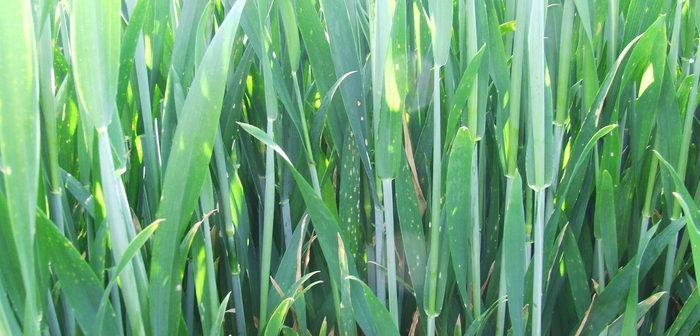Where active powdery mildew is present in susceptible cereal crops, growers are advised to include a specific mildewicide in T0 fungicide applications for early control.
Although not as damaging as other key cereal diseases, such as septoria in wheat and Rhynchosporium in barley, mildew can cause plant stress, tiller loss and ultimately lower yields if left unchecked.
Hamish Coutts, Association of Independent Crop Consultants (AICC) agronomist covering Perthshire, Angus and Fife, says crops in his area are carrying enough mildew to influence his first cereal fungicide recommendations over the next week to 10 days.
“It’s about in both wheat and barley and we will look to include something specific to knock it out,” he adds.
Susceptible varieties
Avon-based independent agronomist Stephen Harrison says cold weather slowed the progression of mildew and is not seeing levels beyond what would typically be expected.
However, the disease is still present in the susceptible wheat varieties under his watch, including Leeds, Claire and Dunston. Winter barley Orwell is also at risk, with a resistance score of just 3 on the AHDB Recommended List.
In these “dirtier” varieties, he favours stamping out mildew before stem extension with 0.15-0.2litres/ha of specific mildewicide Cyflamid (cyflufenamid).
In winter oats, quinoxyfen at GS32 will typically suffice for early control, but the addition of cyflufenamid may also be required if mildew is established.
“It’s a case of keeping watch in other [more resistant]cereal varieties, but there isn’t much out there at the moment,” explains Mr Harrison.
He adds that morpholine fungicides – which provide another specific mildewicide option – have stronger curative activity, but tend to be harsher on the crop than cyflufenamid and can cause a phytotoxic effect.
“That is especially so in barley and the de-waxing of leaves can make crops more susceptible to other diseases such as ramularia later in the season.”
Loose soils
In the East, Downham Market-based agronomist Martyn Cox, who covers Cambridgeshire, Suffolk and Norfolk, places more focus on mildew than it gets nationally, particularly in his late-drilled wheats on the light sands or peaty soils in the Fens.
With consolidation tricky, particularly when dry, manganese deficiency is common and stressed crops tend to suffer severe mildew epidemics that can hinder root growth.
Mr Cox also feels wheat variety ratings for mildew can be misleading when plants are young, with some more susceptible in the autumn and early spring than Recommended List scores suggest and can suffer unexpected levels of infection.
The use of specific mildewicide cyflufenamid at T0 in high-pressure situations helps get on top of the disease early on and supports chemistry used later in the season, he explains.
“Fenpropidin was very useful, but we no longer have it and fenpropimorph is now being withdrawn too.
“We find prothioconazole in the programme is useful on mildew, but it does need backing up where pressure is high. Cyflamid has been very effective for us, particularly in these later-sown and stressed crops,” says Mr Cox.
Curative and protectant
Certis technical specialist Geoffrey Bastard says although cold and wet weather has calmed overall mildew risk in recent days, he is still seeing weaker wheat varieties with active mildew on upper leaves.
With crops approaching or at GS30, he says the inclusion of a specific mildewicide at T0 is a sensible investment where risk is high, giving growers a cleaner start to the main fungicide timings in April.
“Cyflamid has both curative and protectant activity, so will knock out any mildew hanging around in the crop and give two to three weeks’ protection on fresh growth up to the T1 timing.
“It has translaminar and vapour activity, which helps it move through the plant and canopy, so is a very good active against a specific problem like mildew,” adds Geoffrey.
Mildew control – key messages
- Susceptible winter cereals carrying active mildew in some regions
- Late drilled wheats on light land considered high-risk
- Consider a specific mildewicide at T0 to clean up mildew early
- Cyflufenamid offers a crop safe curative and protectant solution




